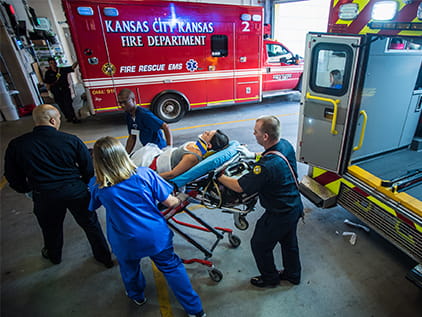Burns
Burns can be quite minor, or serious enough to be life-threatening. Because of this, treatment for burn care varies widely. Appropriate diagnosis and prompt treatment of burns is critical to control and minimize burn damage.
At The University of Kansas Health System, we specialize in advanced burn and wound care at the Gene and Barbara Burnett Burn Center. Our team of specialists offers the best treatments to create a customized burn treatment plan that’s tailored to your individual needs. We also host a monthly support group for burn survivors, providing a therapeutic environment that helps you feel connected and supported throughout your recovery.
What are burns?
Burns occur when body tissues are damaged due to heat, including electrical exposure. Exposure to certain chemicals can also result in a burn. Some burns are minor enough to be treated at home with over-the-counter remedies. Burns that are more serious need prompt attention from burn specialists. Severe burns can require specialized inpatient care at a dedicated burn center.
We offer a variety of appointment types. Learn more or call 913-588-1227 to schedule now.
Types of burns
Burns are classified by the depth of the skin damage:
Burn symptoms and risks
Burn symptoms vary depending on what degree the burn is, but generally include:
- Blisters
- Peeling skin
- Red, white or charred skin
- Swelling
Pain can also be a symptom of burns, but it’s important to remember that the most serious type of burn may actually be painless due to nerve damage. Because of this, pain itself should not be used as an indicator for how severe the burn damage is, as third-degree burns often hurt less than second-degree burns. A serious burn can also cause shock, so shock symptoms may be seen alongside burn symptoms.
Burn prevention is the most important factor in lowering the risk of burn injury. The American Burn Association recommends making simple behavioral and environmental changes to reduce exposure risks, such as following safe cooking tips and checking smoke detectors regularly.
Burn diagnosis and screening
Your doctor will perform a burn evaluation to decide on the best treatment plan for your burn. During a burn evaluation, your doctor will examine the burn injury to determine the depth of the burn.
Another factor your doctor will look at is the total percentage of your body that’s been burned. This calculation is known as total body surface area (TBSA). TBSA is used to decide whether to transfer your treatment to a burn center, as well as for making specific treatment recommendations.
Burn treatment
Treatment for burn injuries varies depending on the type of burn as well as the severity and total body surface area affected. Burn treatments may be inpatient or outpatient.
Why choose us for burn treatment
Specialists at The University of Kansas Health System provide comprehensive inpatient and outpatient care to adults and children with complex burns and wounds. In addition, we treat skin injuries and conditions such as frostbite, severe dermatitis and abrasions. You’ll receive a continuum of advanced care that includes burn wellness programs and a burn survivor support group.
Our multidisciplinary burn care team comprises board-certified plastic surgeons, general surgeons, internal medicine specialists, dermatologists, nurses, physical therapists and nutritionists, among other medical professionals. We collaborate in research to develop advanced techniques to improve burn care for burn survivors now and in the future.

Advanced trauma care
We are the region's most experienced nationally verified Level I Trauma Center, designated by the American College of Surgeons. This distinction recognizes our ability to provide the highest possible standard of care to critically injured patients.




